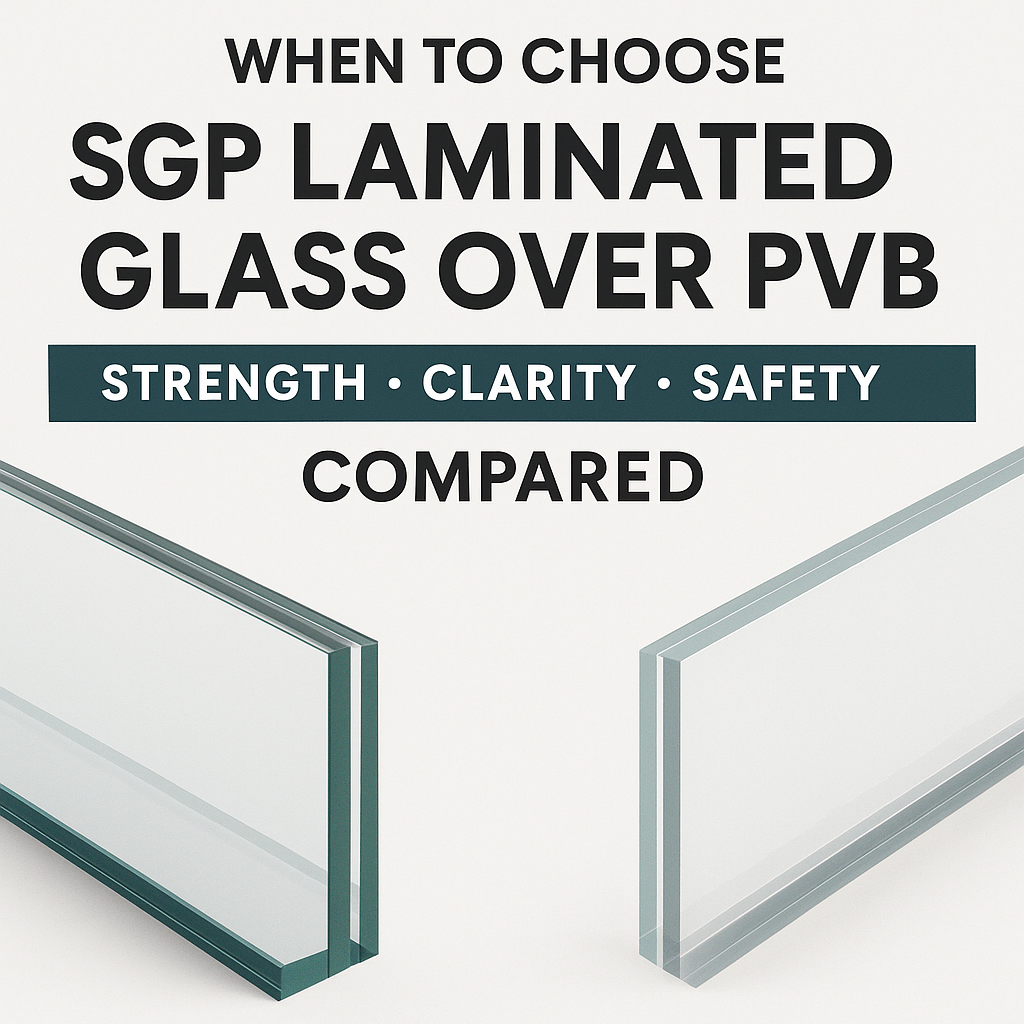Glass selection plays a critical role in the performance, aesthetics, and safety of any building project. Two of the most common interlayers used in laminated glass are PVB (polyvinyl butyral) and SGP (SentryGlas® Plus). While both offer strength and protection, SGP laminated glass excels in specific applications where higher performance is essential.
So how do you know when to choose SGP laminated glass over PVB? This guide compares the two options across durability, load-bearing capacity, environmental performance, and use cases to help architects, engineers, and builders make informed decisions.
What Is SGP Laminated Glass?
SGP laminated glass is a type of safety glass made by bonding two or more layers of glass using an ionoplast interlayer known as SentryGlas® Plus. This interlayer is significantly stronger and stiffer than traditional PVB and is designed to:
- Maintain shape under load
- Resist moisture, UV, and temperature changes
- Hold broken glass fragments in place after impact
- Enable frameless, large-span, or structural installations
SGP is particularly suited for high-performance glazing systems, where both safety and structural integrity are paramount.
Explore its use in towers:
🔗 SGP Laminated Glass for Safer High-Rise Buildings
SGP vs PVB Laminated Glass: What’s the Difference?
| Feature | SGP Laminated Glass | PVB Laminated Glass |
|---|---|---|
| Interlayer Material | Ionoplast | Polyvinyl Butyral |
| Tensile Strength | 5x greater than PVB | Moderate |
| Stiffness | 100x stiffer | Flexible |
| UV & Moisture Resistance | Excellent | Moderate to poor |
| Post-Breakage Performance | Holds shape, supports load | Stretches, may sag |
| Edge Stability | Ideal for exposed applications | Needs edge sealing |
| Clarity Over Time | Maintains transparency | May yellow in UV exposure |
| Cost | Higher | Lower |
When to Choose SGP Laminated Glass Over PVB
1. Structural Glazing and Frameless Systems
In modern architecture, frameless glass systems provide an elegant, minimalist aesthetic. However, they also demand high strength to support loads without additional framing. SGP laminated glass offers the rigidity required for:
- Frameless balustrades
- Point-fixed curtain walls
- Cantilevered balconies
- Glass fins and mullions
PVB, being more flexible, is not suitable for load-bearing without extra structural support.
2. High-Rise or Wind-Loaded Facades
Buildings above 10 stories experience higher wind pressures. In these environments, SGP laminated glass in architecture ensures:
- Minimal deflection under wind load
- Higher panel stability
- Reduced risk of glass fallout
It’s the preferred option for:
- Tower curtain walls
- High-rise atriums
- Overhead sloped glazing
3. Post-Breakage Load Requirements
Certain safety codes require that glass panels maintain load-bearing capacity even after breakage. SGP laminated glass holds broken fragments in place while supporting weight. This is crucial in:
- Glass canopies
- Walkable skylights
- Glass floors
- Emergency exit panels
PVB may stretch or collapse after breakage, increasing hazard risk.
Learn proper setup and safety procedures:
🔗 SGP Laminated Glass Installation
4. Outdoor or Coastal Environments
Humidity, rain, and salt exposure can damage PVB interlayers over time, leading to:
- Edge fogging
- Delamination
- Yellowing
SGP laminated glass is hydrophobic and more UV-stable, making it ideal for:
- Pool fences
- Seaside balconies
- Rooftop terraces
- Outdoor glass canopies
5. Blast or Impact-Resistant Glazing
For buildings that require blast mitigation or forced-entry protection, SGP laminated glass provides:
- Higher impact absorption
- Tear resistance under high load
- Continued barrier after cracking
It’s often used in:
- Government buildings
- Airports and transit stations
- Bank storefronts
- Military and data centers
PVB may fail faster under sustained attack or explosive forces.
6. Long-Term Clarity and Durability
SGP is optically clearer and maintains clarity longer than PVB, which may yellow over time—especially in:
- High-sunlight areas
- Large exterior installations
- Display or gallery glazing
This makes it a top choice for:
- Showrooms
- Museum exhibits
- Transparent facades
Need a breakdown of value vs cost?
🔗 SGP Laminated Glass Price Guide for Modern Construction
When PVB Is Still a Suitable Option
PVB laminated glass remains a viable choice when:
- Cost is a primary concern
- The glazing is framed and not exposed
- Load-bearing is not required
- Post-breakage performance isn’t critical
- Interior partitions or low-rise windows are used
It’s widely used in residential windows, interior walls, and low-traffic commercial spaces.
Cost Consideration: Is SGP Worth It?
While sgp laminated glass price is generally 30–50% higher than PVB, it offers:
- Longer lifespan
- Reduced maintenance
- Enhanced safety and design freedom
- Compliance with advanced building codes
Projects with high structural, environmental, or aesthetic demands will benefit from the long-term return on investment.
Applications Where SGP Clearly Outperforms PVB
- Skyscraper curtain walls
- Frameless stair railings
- Glass bridges and floors
- Balcony safety barriers
- Blast-rated glazing
- Skylights and atriums
- Swimming pool enclosures
In each of these scenarios, SGP laminated glass in design delivers better load resistance, edge clarity, and long-term performance.
SEO-Friendly Keyword Variants
- sgp vs pvb laminated glass comparison
- laminated glass for structural glazing
- sgp laminated glass for curtain walls
- pvb vs sgp for glass balustrades
- safest laminated glass interlayer
- sgp glass load capacity
- when to use sgp laminated glass
- sgp laminated glass moisture resistance
- exterior laminated glass solutions
- best glass interlayer for facades
Conclusion
Choosing between SGP laminated glass and PVB laminated glass comes down to project needs. If you’re working on a structure that demands safety, strength, transparency, and durability—particularly in exposed or load-bearing areas—SGP is the superior solution.
While the initial cost may be higher, the long-term benefits in performance and peace of mind make SGP the go-to choice for architects and engineers pushing boundaries.
Continue learning with:
🔗 SGP Laminated Glass for Safer High-Rise Buildings
🔗 SGP Laminated Glass Installation
🔗 SGP Laminated Glass Price Guide for Modern Construction

